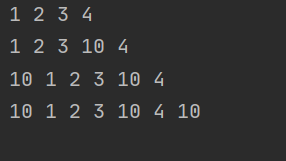数据结构 链表的各种插入
本文共 1261 字,大约阅读时间需要 4 分钟。
提示:文章写完后,目录可以自动生成,如何生成可参考右边的帮助文档
文章目录
前言
链表的任意的位置插入时间复杂度都是O(1),没有增容问题,插入一个就开辟一个空间,这是链表相对于顺序表的优点,那么我们就来看看这个各种插入是怎样插入的。
1.中间位置插入

public static Node MidInsertion(Node head,Node Insert,int index){ Node cur = head; if(index<1||index>Length(head))//插入位置越界了,位置不能是头部 return cur; for (int i=0;i 因为输入了要插入位置的下标,那就得到个位置结束for循环,这时候cur就指向该下标的的节点了,这时候修改要插入的节点的指向就可以了,注意这里修改的循序不能打乱。
2.头部插入
public static Node HeadInsertion(Node head,Node Insert){ Node cur = head; Insert.next=cur; cur=Insert; return cur; } 头部插入这里只需要更改指向就可以了,不用在进行遍历了,使头结点的引用指向要插入的结点,插入的节点的next指向原来的头结点。
3.尾部插入
public static Node LastInsertion(Node head,Node Insert){ Node cur=head; while(cur.next!=null){ cur=cur.next; } cur.next=Insert; return head; } 尾插入需要先走到链表的末尾,然后只要让原来指向null的最后一个节点,指向要插入的节点就可以了。
验证
public static void main(String[] args) { Node head=GreateLink(); print(head); Node Insert=new Node(10); MidInsertion(head,Insert,3); print(head); Node Insert1=new Node(10); head=HeadInsertion(head,Insert1); print(head); Node Insert2=new Node(10); LastInsertion(head,Insert2); print(head); } 
转载地址:http://tsog.baihongyu.com/
你可能感兴趣的文章
nodejs框架,原理,组件,核心,跟npm和vue的关系
查看>>
Nodejs概览: 思维导图、核心技术、应用场景
查看>>
nodejs模块——fs模块
查看>>
Nodejs模块、自定义模块、CommonJs的概念和使用
查看>>
nodejs生成多层目录和生成文件的通用方法
查看>>
nodejs端口被占用原因及解决方案
查看>>
Nodejs简介以及Windows上安装Nodejs
查看>>
nodejs系列之express
查看>>
nodejs系列之Koa2
查看>>
Nodejs连接mysql
查看>>
nodejs连接mysql
查看>>
NodeJs连接Oracle数据库
查看>>
nodejs配置express服务器,运行自动打开浏览器
查看>>
NodeMCU教程 http请求获取Json中文乱码解决方案
查看>>
Nodemon 深入解析与使用
查看>>
NodeSession:高效且灵活的Node.js会话管理工具
查看>>
node~ http缓存
查看>>
node不是内部命令时配置node环境变量
查看>>
node中fs模块之文件操作
查看>>
Node中同步与异步的方式读取文件
查看>>